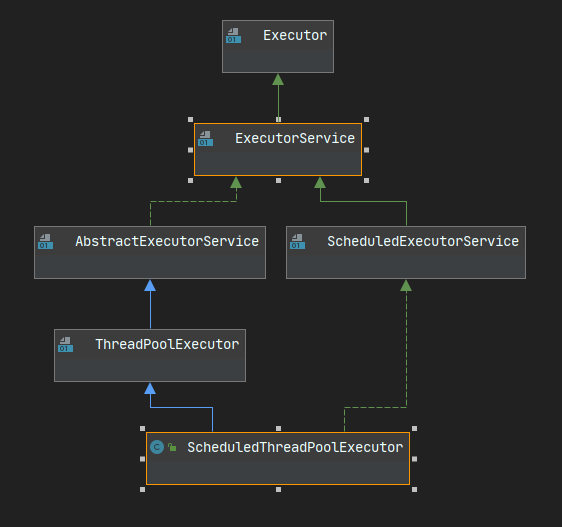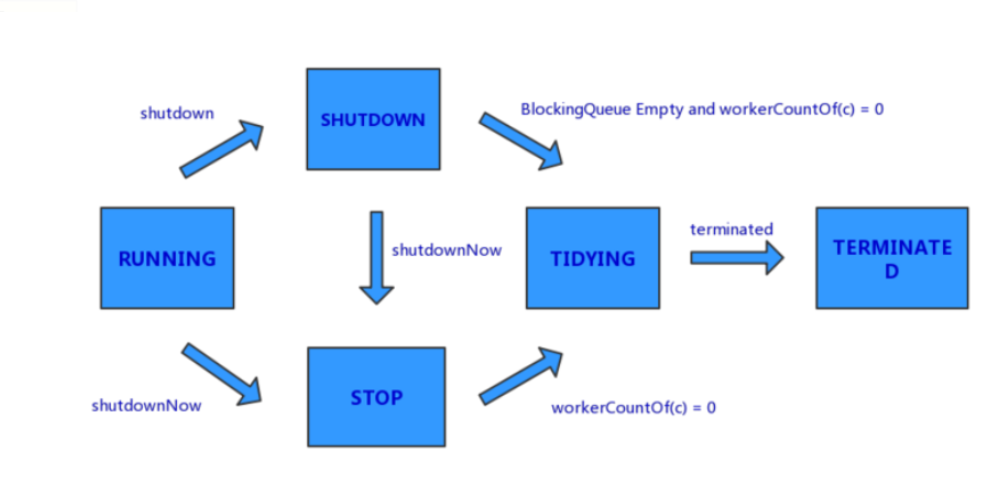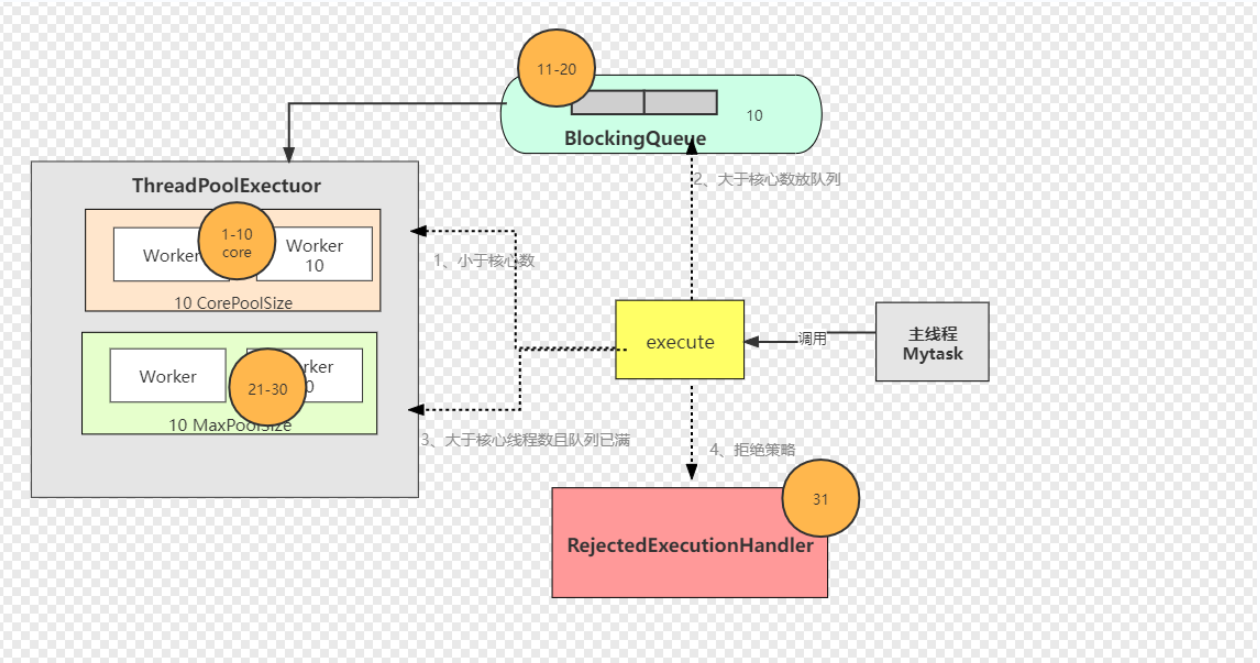常用线程池
ThreadPoolExecutor解析
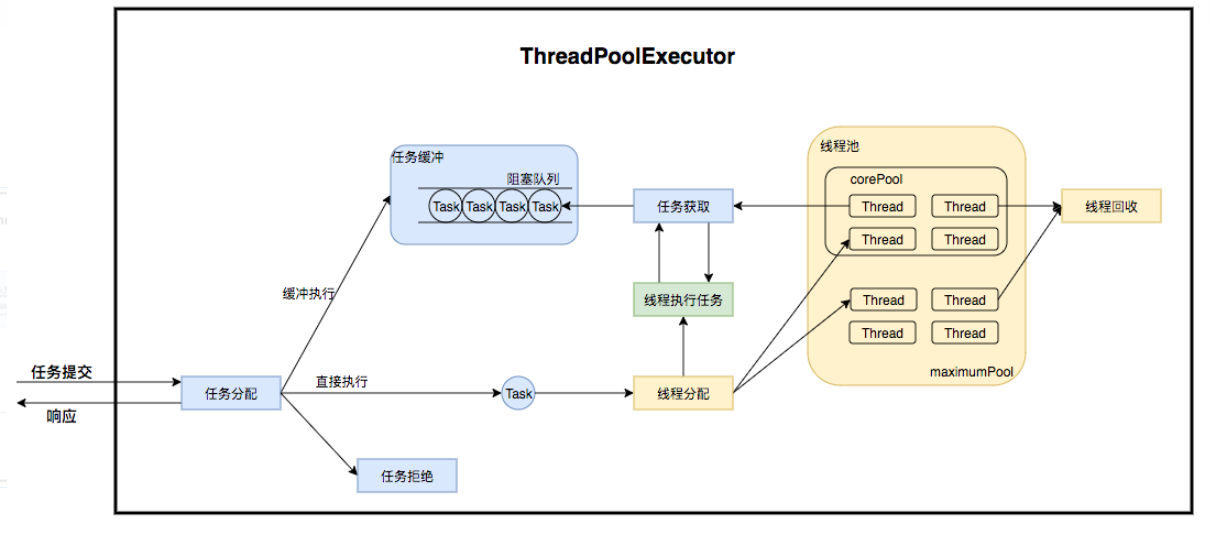
阿里不推荐使用:
内部的无界队列,造成oom
自定义线程池:ThreadPoolExecutor threadPoolExecutor = new ThreadPoolExecutor(10, 20, 0L, TimeUnit.MILLISECONDS, new LinkedBlockingQueue<Runnable>(10));
源码分析
流程图:
线程池处理流程
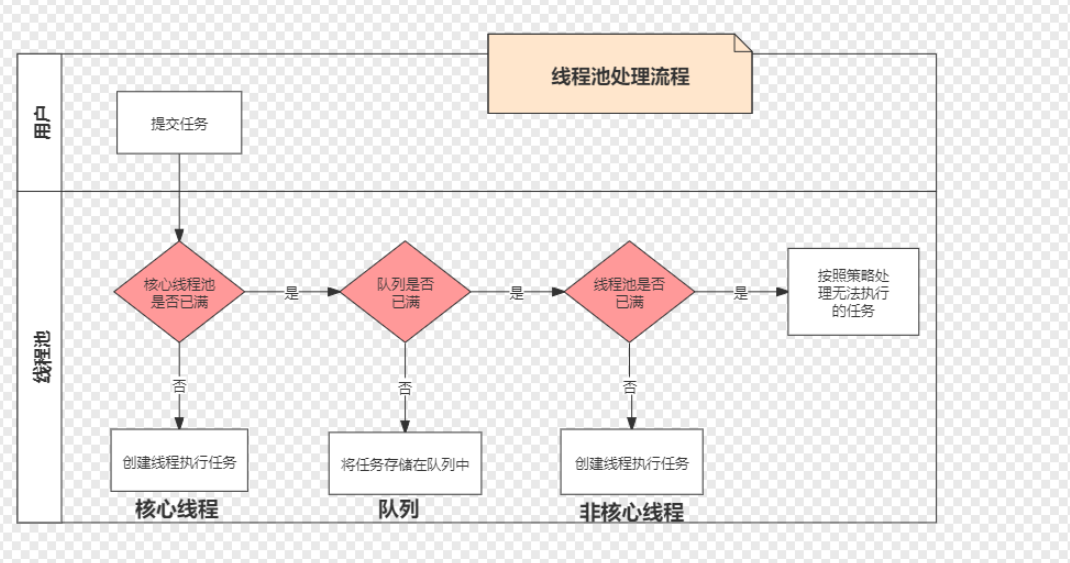

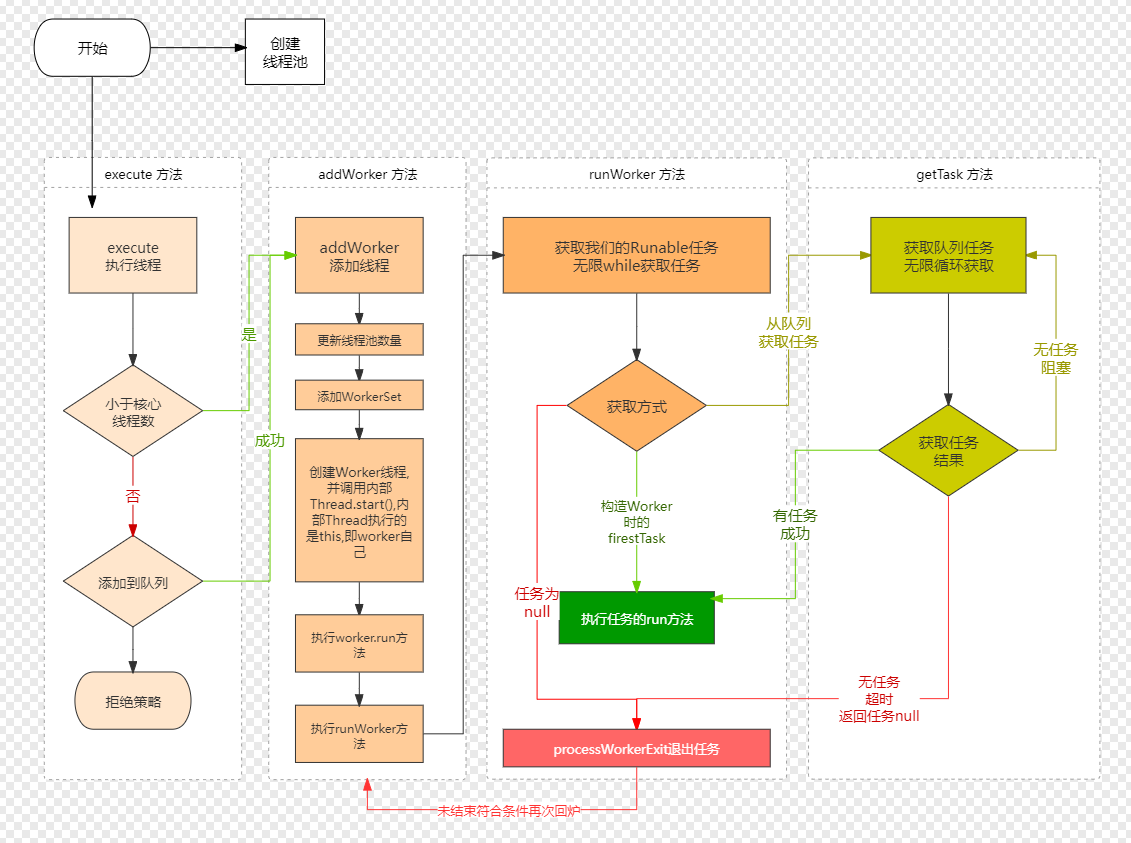
private static final int COUNT_BITS = Integer.SIZE - 3;private static final int CAPACITY = (1 << COUNT_BITS) - 1;// runState is stored in the high-order bitsprivate static final int RUNNING = -1 << COUNT_BITS;private static final int SHUTDOWN = 0 << COUNT_BITS;private static final int STOP = 1 << COUNT_BITS;private static final int TIDYING = 2 << COUNT_BITS;private static final int TERMINATED = 3 << COUNT_BITS;
COUNT_BITS:int位数 = 32-3
实际上使用32位中的高3位表示
execute方法:
int c = ctl.get();1、当前的线程数是否小于corePoolSize,如果是,使用入参任务通过addWord方法创建一个新的线程,如果能完成新线程创建exexute方法结束,成功提交任务;if (workerCountOf(c) < corePoolSize) {if (addWorker(command, true))return;c = ctl.get();}2、没有完成任务提交;状态为运行并且能成功加入任务到工作队列后,再进行一次check,如果状态在任务加入队列后变为了非运行(有可能是在执行到这里线程池shutdown了)非运行状态下当然是需要reject;然后再判断当前线程数是否为0(有可能这个时候线程数变为了0),如是,新增一个线程;if (isRunning(c) && workQueue.offer(command)) {int recheck = ctl.get();if (! isRunning(recheck) && remove(command))reject(command);else if (workerCountOf(recheck) == 0)//判断当前工作线程池数是否为0addWorker(null, false);//如果是创建一个null任务,任务在堵塞队列存在了就会从队列中取出 这样做的意义是//保证线程池在running状态必须有一个任务在执行}3、如果不能加入任务到工作队列,将尝试使用任务新增一个线程,如果失败,则是线程池已经shutdown或者线程池已经达到饱和状态,所以reject;拒绝策略不仅仅是在饱和状态下使用,在线程池进入到关闭阶段同样需要使用到;:else if (!addWorker(command, false))reject(command);
z总结:
- 如果当前线程数小于corePoolSize, 通过addWorker创建新线程,
如果能完成新线程创建execute方法结束,成成功提交任务 - 如果上一步没有完成提交任务,状态为运行态并且假如任务队列,再check一次
如果状态再任务假如队列后变为非运行(线程池挂了),就执行reject,
判断当前线程数是否为0,如果没了,新增一个线程 - 如果不能加入道工作队列,就尝试使用任务新增线程,如果线程池已经shutdown或满了,
也会reject,
reject:饱和状态下,线程池关闭阶段也会用到
addWorker方法
private boolean addWorker(Runnable firstTask, boolean core) {retry: goto写法 用于重试for (;;) {int c = ctl.get();int rs = runStateOf(c);// Check if queue empty only if necessary.if (rs >= SHUTDOWN &&! (rs == SHUTDOWN &&firstTask == null &&! workQueue.isEmpty()))线程状态非运行并且非shutdown状态任务为空,队列非空就不能新增线程了return false;for (;;) {int wc = workerCountOf(c);if (wc >= CAPACITY ||wc >= (core ? corePoolSize : maximumPoolSize))当前现场大于等于最大值等于核心线程数 非核心大于等于线程池数 说明达到了阈值最大线程数 就不新增线程return false;if (compareAndIncrementWorkerCount(c)) ctl+1 工作线程池数量+1 如果成功就跳出死循环。cas操作 如果为true 新增成功 退出break retry;c = ctl.get(); // Re-read ctlif (runStateOf(c) != rs)continue retry; 进来的状态和此时的状态发生改变 重头开始 重试// else CAS failed due to workerCount change; retry inner loop}}上面主要是对ctl工作现场+1boolean workerStarted = false;boolean workerAdded = false;Worker w = null;try {w = new Worker(firstTask); 内部类 封装了线程和任务 通过threadfactory创建线程final Thread t = w.thread; 毎一个worker就是一个线程数if (t != null) {final ReentrantLock mainLock = this.mainLock;mainLock.lock();try {// Recheck while holding lock.// Back out on ThreadFactory failure or if// shut down before lock acquired.重新获取当前线程状态int rs = runStateOf(ctl.get());小于shutdown就是running状态if (rs < SHUTDOWN ||(rs == SHUTDOWN && firstTask == null)) {SHUTDOWN 和firstTask 为空是从队列中处理任务 那就可以放到集合中线程还没start 就是alive就直接异常if (t.isAlive()) // precheck that t is startablethrow new IllegalThreadStateException();workers.add(w);int s = workers.size();if (s > largestPoolSize)largestPoolSize = s; 记录最大线程数workerAdded = true;}} finally {mainLock.unlock();}if (workerAdded) {t.start(); 启动线程workerStarted = true;}}} finally {if (! workerStarted)addWorkerFailed(w);//失败回退 从wokers移除w 线程数减1 尝试结束线程池}return workerStarted;}
private final class Workerextends AbstractQueuedSynchronizerimplements Runnable{/*** This class will never be serialized, but we provide a* serialVersionUID to suppress a javac warning.*/private static final long serialVersionUID = 6138294804551838833L;/** Thread this worker is running in. Null if factory fails. */正在运行woker线程final Thread thread;/** Initial task to run. Possibly null. */传入的任务Runnable firstTask;/** Per-thread task counter */完成的任务数 监控用volatile long completedTasks;/*** Creates with given first task and thread from ThreadFactory.* @param firstTask the first task (null if none)*/Worker(Runnable firstTask) {禁止线程中断setState(-1); // inhibit interrupts until runWorkerthis.firstTask = firstTask;this.thread = getThreadFactory().newThread(this);}/** Delegates main run loop to outer runWorker */public void run() {runWorker(this);}
runwoker方法:
final void runWorker(Worker w) {Thread wt = Thread.currentThread();//获取当前线程Runnable task = w.firstTask;w.firstTask = null;w.unlock(); // allow interrupts 把state从-1改为0 意思是可以允许中断boolean completedAbruptly = true;try { task不为空 或者阻塞队列中拿到了任务while (task != null || (task = getTask()) != null) {w.lock();// If pool is stopping, ensure thread is interrupted;// if not, ensure thread is not interrupted. This// requires a recheck in second case to deal with// shutdownNow race while clearing interrupt如果当前线程池状态等于stop 就中断//Thread.interrupted() 中断标志if ((runStateAtLeast(ctl.get(), STOP) ||(Thread.interrupted() &&runStateAtLeast(ctl.get(), STOP))) &&!wt.isInterrupted())wt.interrupt();try {beforeExecute(wt, task);Throwable thrown = null;try {task.run();} catch (RuntimeException x) {thrown = x; throw x;} catch (Error x) {thrown = x; throw x;} catch (Throwable x) {thrown = x; throw new Error(x);} finally {afterExecute(task, thrown);}} finally {task = null; 这设置为空 等下次循环就会从队列里面获取w.completedTasks++; 完成任务数+1w.unlock();}}completedAbruptly = false;} finally {processWorkerExit(w, completedAbruptly);}}
getTask方法:
private Runnable getTask() {boolean timedOut = false; // Did the last poll() time out?for (;;) {int c = ctl.get();int rs = runStateOf(c);//获取线程池运行状态shuitdown或者weikong 那就工作现场-1 同事返回为null// Check if queue empty only if necessary.if (rs >= SHUTDOWN && (rs >= STOP || workQueue.isEmpty())) {decrementWorkerCount();return null;}重新获取工作线程数int wc = workerCountOf(c);timed是标志超时销毁allowCoreThreadTimeOut true 核心线程池也是可以销毁的// Are workers subject to culling?boolean timed = allowCoreThreadTimeOut || wc > corePoolSize;if ((wc > maximumPoolSize || (timed && timedOut))&& (wc > 1 || workQueue.isEmpty())) {if (compareAndDecrementWorkerCount(c))return null;continue;}try {Runnable r = timed ?workQueue.poll(keepAliveTime, TimeUnit.NANOSECONDS) :workQueue.take();if (r != null)return r;timedOut = true;} catch (InterruptedException retry) {timedOut = false;}}}
processWorkerExit方法:
private void processWorkerExit(Worker w, boolean completedAbruptly) {if (completedAbruptly) // If abrupt, then workerCount wasn't adjusteddecrementWorkerCount();final ReentrantLock mainLock = this.mainLock;mainLock.lock();try {completedTaskCount += w.completedTasks;workers.remove(w);} finally {mainLock.unlock();}tryTerminate();int c = ctl.get();if (runStateLessThan(c, STOP)) {if (!completedAbruptly) {int min = allowCoreThreadTimeOut ? 0 : corePoolSize;if (min == 0 && ! workQueue.isEmpty())min = 1;if (workerCountOf(c) >= min)return; // replacement not needed}addWorker(null, false);}}
ThreadPoolExecutor内部有实现4个拒绝策略:
(1)、CallerRunsPolicy,由调用execute方法提交任务的线程来执行这个任务;
(2)、AbortPolicy,抛出异常RejectedExecutionException拒绝提交任务;
(3)、DiscardPolicy,直接抛弃任务,不做任何处理;
(4)、DiscardOldestPolicy,去除任务队列中的第一个任务(最旧的),重新提交;
实际上需要自定义处理
public class MyRejectedExecutionHandler implements RejectedExecutionHandler {@Overridepublic void rejectedExecution(Runnable r, ThreadPoolExecutor executor) {}}
